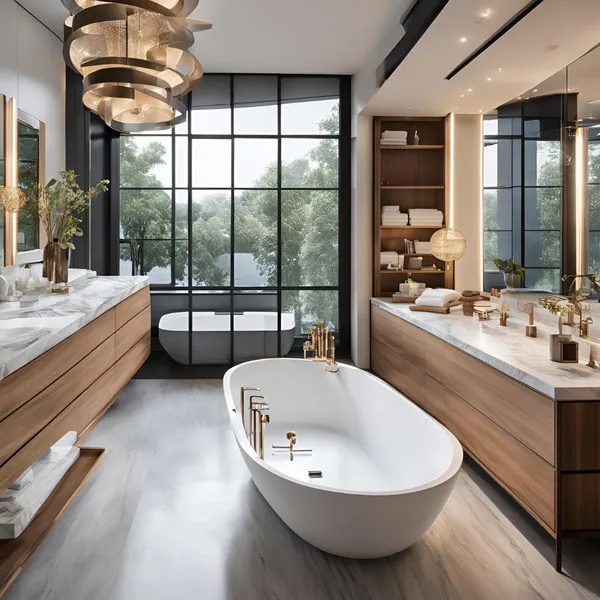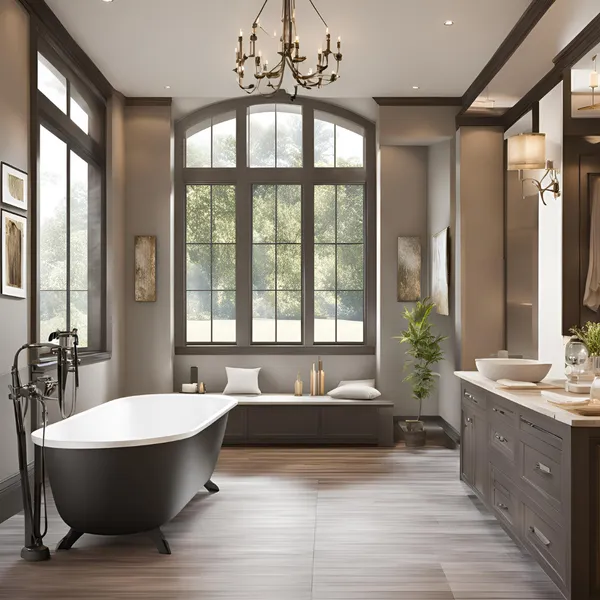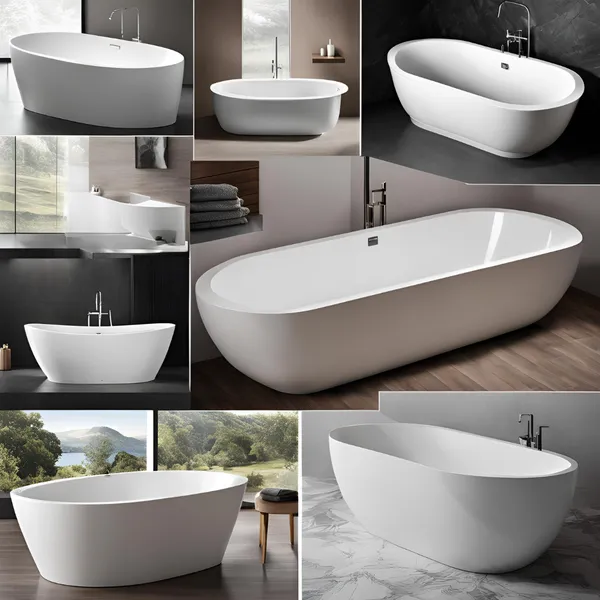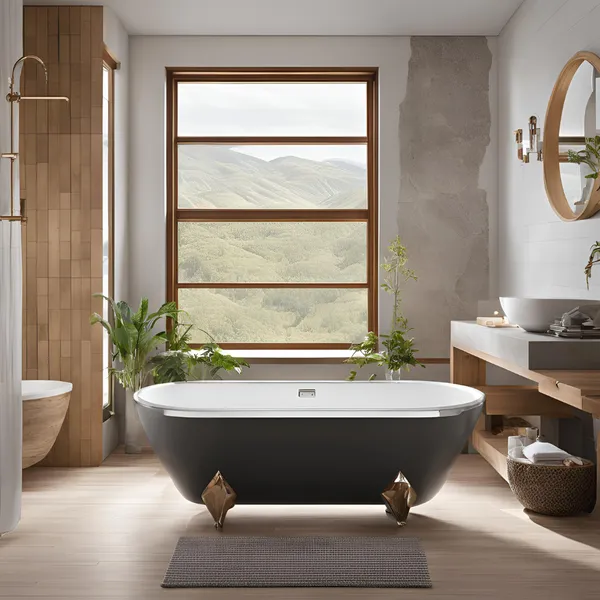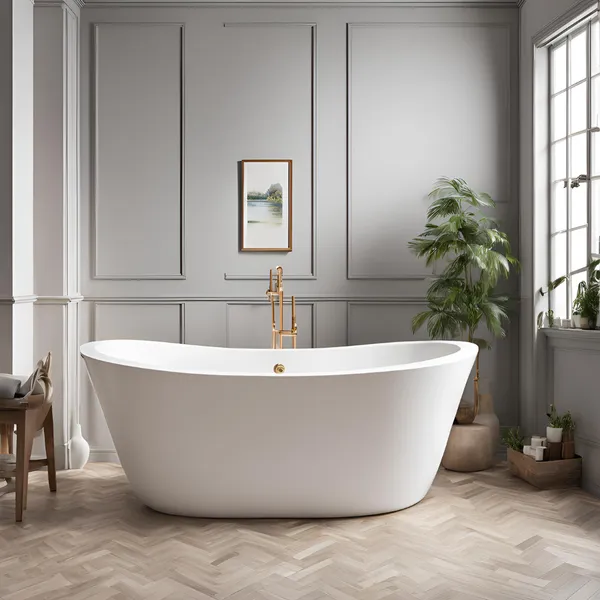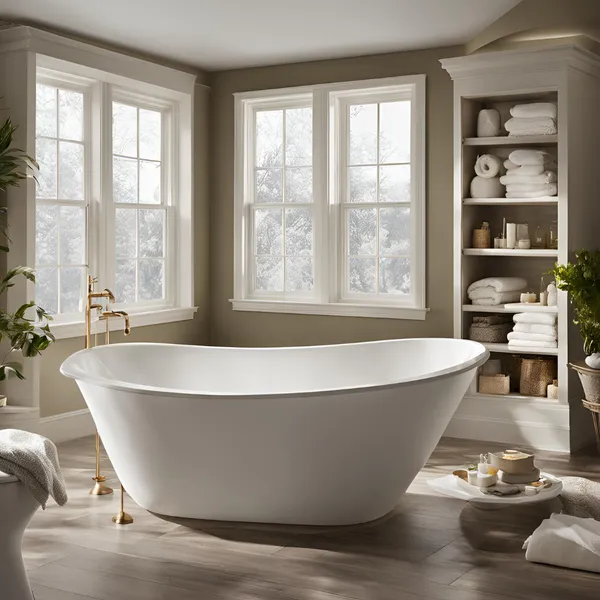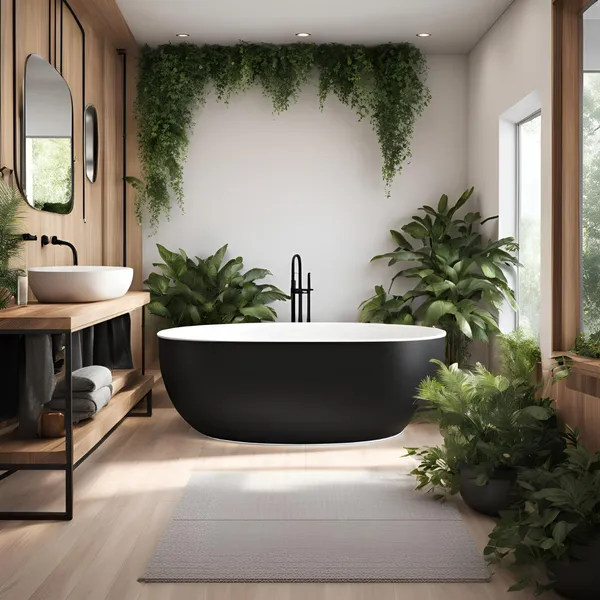Bathtubs are another excellent item that may add comfort to your house lot because having a warm bath after a tiring day is nice. But, when there are many options for creating the bathtub, choosing the proper variant becomes challenging.
This blog post will highlight various types of bathtubs: the freestanding bathtub, the alcove bathtub, and the corner bathtub, as well as guidelines on choosing the best bathtub for your needs and the design of your bathroom.
Types of Bathtubs
Here’s a more detailed look at the common types of bathtubs:
1. Freestanding Bathtubs
What they are: Conceive a bathtub that sits freestanding on its right rather than being fitted to a wall. Well, at least that’s the case with a freestanding tub! Unlike other vanities, this design lets you bring it to any area of your bathroom (depending on your plumbing) and instantly upgrade your look.
Pros:
- Style: Freestanding tubs are the rebels of the bathtub world, or they are like the supermodels of the bathtub world. It arrives in many stylish serving sizes and cut materials. Consider an antique clawfoot tub with curved feet, a smooth oval tub, a slipper tub, and a high back to provide more comfort during the bath. A freestanding tub exists, suitable for any bathroom design.
- Placement: Do you want to locate your tub near a window so you can enjoy the scenery while in the tub? Or place it in the corner of the room where you can make a nice corner to read. When it comes to a freestanding bath, they allow you complete freedom when making your ideas a reality.
- Luxury: There is some inherent glamour to having a freestanding tub that has been gifted to you. It transforms your bathroom into a sanctuary where, upon entering it–you instantly get rid of all the stressors of the day, and all that is left is to take a break and relax.
Cons:
- Space: Alcove tubs are nondraining, and freestanding tubs are more profound and thus have a larger basin than the other types. If you have a small bathroom, this might not be the best idea for your home.
- Cost: When it comes to luxury, nothing is cheap, especially when it comes to freestanding bathtubs. Usually, they are more costly than other types of tubs in the market.
- Plumbing: The plumbing for a freestanding tub may require additional work and is likely to be more expensive if one moves it far from the main lines.
- Storage: Also, it is characteristic that most freestanding tubs don’t have ledges or decks on which you may place your soaps, shampoos and other bathing accessories. That means you will have to look for different forms of storage.
2. Alcove Bathtubs
What they are: This is probably the most prevalent type of bathtub out there and the kind you’ll find in most houses. Built to be installed in a nook with only three walls, alcove tubs use every little bit of the bathroom.
Pros:
- Space-saving: If you have a small bathroom space, an alcove tub should be your BFF. It should be as large as possible while built to fit perfectly into the typical size of an alcove.
- Cost-effective: Alcove tubs are often the cheapest type, and if you have a limited amount to spend on bathroom renovations, these are the best.
- Easy installation: As they can be placed into a standard space, alcove tubs are generally more accessible and cheaper to fit than other kinds.
- Shower combo: As most always, alcove tubs are meant to be used alongside a shower, so you get both in one desirable package.
Cons:
- Style: Although alcove tubs are functional, they are not as dramatic as freestanding.
- Limited sizes: Alcove tubs are often designed in a standard range of dimensions, which is unsuitable if you have a custom bathroom with an irregular shape or precise measurements.
3. Corner Bathtubs
What they are: First of all, the name says it all – corner bathtubs are intended to fit into a corner in your bathroom and, in most cases, come in with a curved or angled front to give the otherwise unused room a stylish look.
Pros:
- Space optimisation: Corner tubs allow optimum use from small corner areas in your bathroom.
- Style: Most corner tubs have a sleek design that gives your bathroom a befitting appearance.
- Size variety: Corner tubs are also available in various sizes, small for small bathrooms and big and deluxe ones.
Cons:
- Accessibility: He noted that corner tubs can be a little more challenging to enter and exit, mainly for persons with limited mobility, depending on the design.
- Cleaning: The edges may be somewhat challenging to clean due to their shape, so get ready to spend some extra time with the sponge!
4. Drop-in Bathtubs
What they are: Consider a bathtub like a white piece of paper in front of you where you paint. That is what a drop-in tub entails! It is intended to be ‘inserted into’ a surrounding deck or platform of your own making. This platform can be constructed of tile, stone, or wood, meaning there are many options for the application’s design.
Pros:
- Customisation: This is the best bathtub to demonstrate your creativity freely. This also allows you to select the type of material, shape, and size of the surrounding deck to ideally facilitate its integration with your bathroom.
- Luxury: Most drop-in tubs give the look and feel of a spa when combined with sophisticated decks such as marble or granite.
- Versatility: The drop-in tubs can be installed anywhere in the bath, provided a deck supports the tub’s placement. This makes it easy for you to plan your bathroom since you have flexibility in the design and layout.
Cons:
- Cost: Adding a deck to your bathtub means employing a contractor’s services to build it from scratch, which can be expensive.
- Space: The deck creates additional enclosure space for the bathtub; hence the entire tub’s dimensions will be bigger than the bathtub only.
5. Undermount Bathtubs
What they are: Undermount tubs are almost like the fancy sisters of the drop-in bathtub. They are also placed on a deck, but the upper border of the tub is located under the deck’s construction. This gives a neat finish with blocks of colour that blend well in a washroom design primarily associated with contemporary style.
Pros:
- Modern aesthetic: Undermount tubs are preferred in contemporary bathroom designs since the tubs are wholly concealed with the countertop.
- Easy cleaning: Because there is no rim or lip for dirt and grime to cling t on the underside of the tubo, under-mount tubs are very easy to clean. All you have to do is clean the deck, and you’re finished!
Cons:
- Cost: As with the drop-in tubs, undercounts may be costly, mainly if high-quality material is used on the countertop.
- Installation: Undermount tub installation calls for proper assessment of the area where the tub is to be placed and professional workmanship to guarantee a perfect fit and sealing system.
6. Walk-in Bathtubs
What they are: The accessibility major on most walk-in baths. They come as a lockable door that opens to allow an individual to step and sit in the tub, then close the door and fill it with water. For this reason, this type of bath is appropriate for the physically disabled or anybody who does not want to struggle with bathtubs.
Pros:
- Safety: These tubs eliminate the possibility of accidents by falls while getting in and out of the tub compared to standard tubs.
- Comfort: Features of walk-in tubs usually added include built-in seats, grab bars and hydrotherapy jets.
Cons:
- Space: Most walk-in tubs are more significant than regular tubs, which accommodate doors and other aspects.
- Cost: It is generally more costly than usual bathtubs because of the features tailored to it.
- Time: Cleaning a walk-in bathtub takes a little longer than cleaning a regular bathtub because of the size of the bathtub.
Factors to Consider When Choosing the Right Bathtub
When choosing a bathtub, there are a few factors you need to consider:
- Your Needs: In your mind, what are you to get from your bathtub? Do you need a bathtub to take a pleasant bath, bathe children, or shower?
- Your Bathroom Style: What kind of bath type do you have? Are you going for a traditional, modern, or contemporary home?
- Your Budget: What is your ability or willingness to pay for a bathtub purchase?
- Your Space: What is the size of your bathroom?
- Your Personal Preferences: Now let me ask you, which features are essential for you in a bathtub? What kind of tub are you looking for? If you are looking for penthouse baths, do you prefer tubs with built-in jets or heaters?
Advice on How to Select the Right Bathtub
Selecting a bathtub is sometimes a tough call, and those tips could do more elaboration. Here’s a more comprehensive guide to help you make the perfect choice:
1. Measure Your Bathroom and the doorway
Get those dimensions: Before you go for the tub that you have fallen in love with, get a measuring tape and take your time to measure the area you wish to place the tub—measures for space: length, width and height of the region.
Consider doorways and hallways: Do not forget to find out the dimensions of doorways and halls where your bathroom is located. When you try to rush through the door, that beautiful stand-alone bathtub will not be of much use to you.
Factor in clearances: Still, do not neglect clearances! There must be enough room for easy manoeuvrability across the tub, to open closets or any cabinets, reach the shower control, or access a bathtub/shower combination. Ideally, a space should be over 24 inches around the tub.
2. Honestly Assess Your Lifestyle
- Bathing habits: How often do you take baths? Do you prefer to dip into your spirituality occasionally, or are you ever the long, relaxing bath of the spirituality world? It will determine the size and depth of the tub you require. I
- Who will be using it? Will the kids be using the tub? If so, decide on such additions as a slip-resistant surface and lower tub walls if it is too high for a person to enter. Do you have some problems with the movements in your body? It might be easier to get a walk-in tub.
- Cleaning routine: Don’t lie about your cleaning habits. If you do not like washing, select a material you could easily clean or use, such as acrylic or glossy enamel.
3. Set a Realistic Budget (and Stick to It!)
- Bathtub costs: Choosing a bathtub and its location can cost anything from a couple hundred to several thousand dollars. This is important as it will help you know your limit once you begin your shopping spree.
- Installation costs: Another hidden cost to consider is installation costs, as this depends on the work complexity or your region. At least proposals from different plumbers or contractors should be collected.
- Hidden costs: That is why you have the expenses of the new plumbing fixtures, the tiles or changes in your bathroom layout.
4. Dive Deep into Your Research
- Online reviews: Surf the internet for feedback from buyers of the various bathtub brands and models to learn about the brand’s quality, DBR brands’ ability, and reputation of sit showrooms. Buy the magazine. Bathroom showrooms and looking at different types of baths will give you a preliminary understanding of their dimensions, design, and fabric.
- Compare prices: Rarely buy from just one shop; compare prices to get the best price. Don’t be afraid to negotiate!
5. Think about the Kind of Material Related to Its Feeling
- Cast iron: It preserves heat well and is known for its durability and class, but it has the added drawbacks of being heavy and costly.
- Acrylic: Inexpensive and quick to heat, the coated surface is more straightforward to clean than the cast iron one but less functional.
- Fiberglass is cheap and has less weight, but it can be easily scratched and fade away.
- Stone resin: Sturdy and gives a protective coat to the item while being fashionable. It comes in various colours and materials but may be costlier.
6. Don’t Be Afraid to Seek Expert Advice
- Plumbers and contractors: Discuss with plumbers and contractors and learn more about installing the air conditioning system and what can hinder it.
- Bathroom designers: A bathroom designer is a good person to consult when deciding which bathtub is appropriate and suitable for the bathroom.
- By following these tips, you will be sure to decide on the right bathtub for you and your bathroom and one that is within your means. Happy soaking!
Conclusion
Selecting the appropriate bathtub is not an easy affair. However, if you have to try and estimate your requirements, the style of your bathroom and how much you are willing to spend, then the right bathtub for your home is out there.
